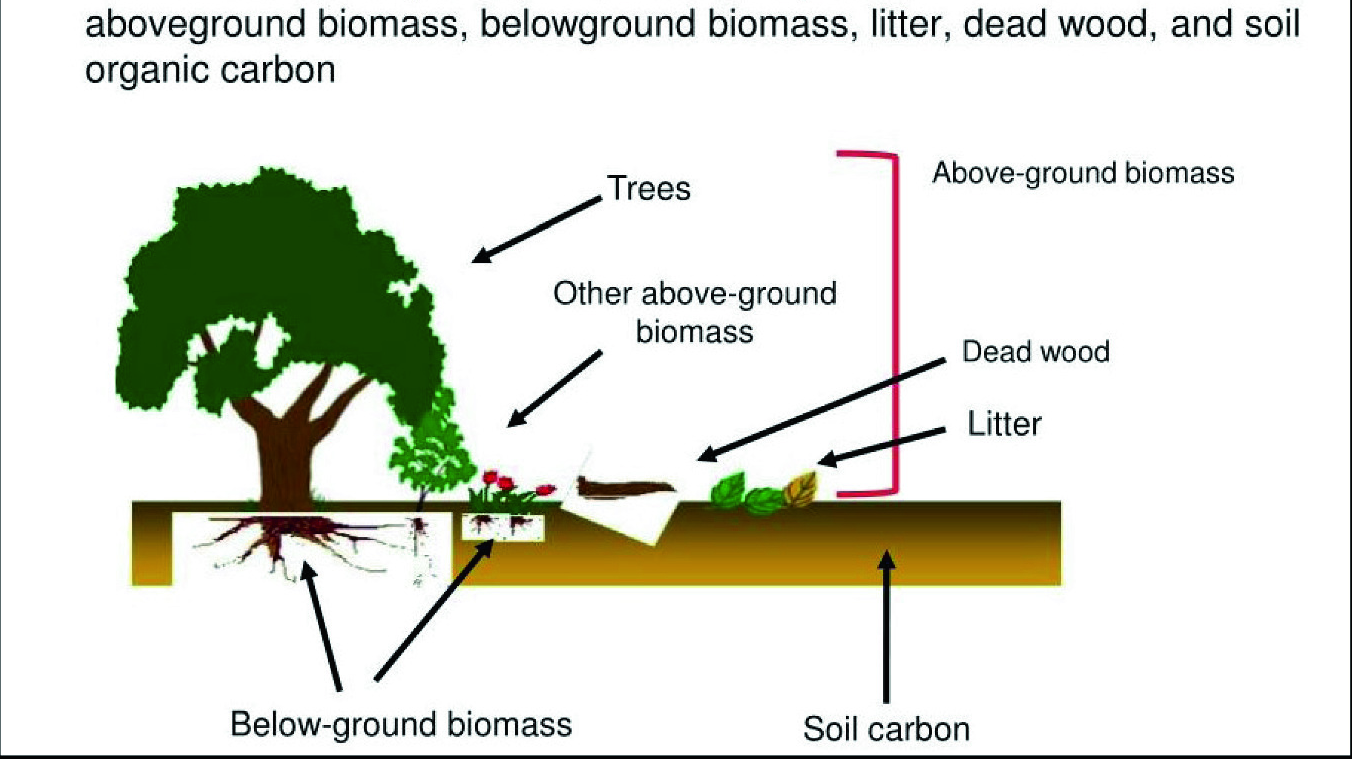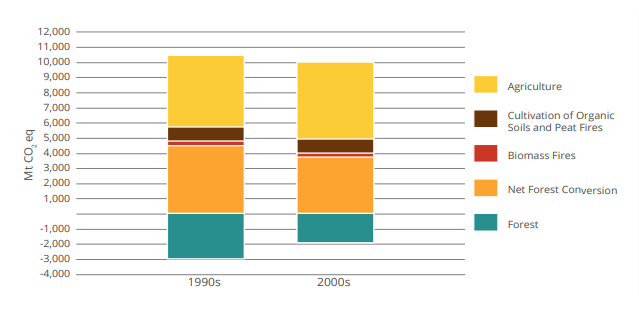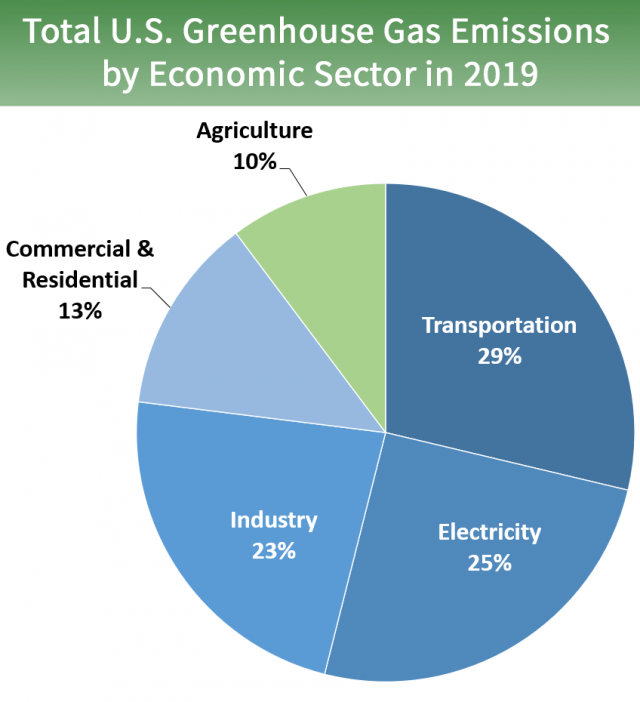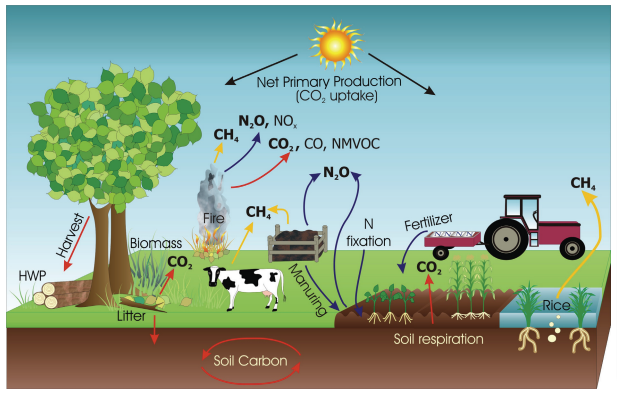Agriculture, Forestry, and Other Land Use (AFOLU) plays a central role for food security and sustainable development . Plants take up carbon dioxide from the atmosphere and nitrogen from the soil when they grow, redistributing it among multiple pools, including above and below-ground living biomass, dead residues, and soil organic matter.
Pool is a system which has the capacity to accumulate or release carbon.
Aboveground Biomass:- Above ground standing dry mass of leaves and dead matter from the tree or shrubs or live worms expressed as mass per unit area.
Belowground Biomass:- It corresponds to woody (axial roots) and non-woody (fine roots) tissues present in the tree root system.

The CO2 and other greenhouse gases released by plants include methane and nitrous oxide , as well as the decomposition of dead plants and soil organic matter. Anthropogenic activities (e.g., management of croplands, forests, grasslands, wetlands) and changes to land use/cover (e.g., conversion of forest to cropland, pasture, afforestation) alter these natural processes. The activities of AFOLU lead to both sources of CO2 (e.g., deforestation, peat land drainage) and sinks of CO2 (e.g., afforestation, management for soil, carbon sequestration), as well as nonCO2 emissions predominantly from agriculture (e.g., CH4 from livestock and rice cultivation, N2O from manure storage and agricultural soils and biomass burning).
Carbon sequestration refers to the process of capturing emissions of atmospheric carbon dioxide and storing them. It is one way of reducing carbon dioxide concentration in the atmosphere in order to slow global climate change.


The key greenhouse gases of concern are CO2, N2O and CH4. CO2 fluxes between the atmosphere and ecosystems are primarily controlled by uptake through plant photosynthesis and releases via respiration, decomposition and combustion of organic matter.

Emission and Removal Processes
Greenhouse gas fluxes in the AFOLU Sector can be estimated in two ways:
- Finding net changes in C stocks over time (used for most CO2 fluxes)
- Directly finding gas flux rates to and from the atmosphere (used for estimating non-CO2 emissions and some CO2 emissions and removals).
Below are the major ecosystem stocks and processes associated with emission and removal in the AFOLU Sector, grouped by components, i.e.,
- Biomass
- Dead Organic Matter
- Soils
- Livestock
Biomass
Plant biomass, including above- and below-ground components, is the main mechanism for removing CO2 from the atmosphere. The exchange of CO2 between the atmosphere and terrestrial ecosystems is largely controlled by photosynthesis and respiration.
Dead Organic Matter
The majority of biomass generated in living plant material ends up in dead organic matter (DOM) pools (dead wood, for instance). DOM sometimes decomposes rapidly, releasing carbon into the atmosphere. However, a substantial amount of carbon is retained for months, years, or even decades. Through the decomposition rate and input of fresh organic matter, land use and management affect C stocks of dead organic matter. The burning of dead organic matter results in the release of CO2, N2O, CH4, NOx, NMVOC, and CO.
Soils
As organic matter decomposes, it is transformed into soil organic matter. In soil, organic matter is composed of a variety of compounds that reside for varying periods. The majority of this material is biodegradable, and much of it can be easily decomposed by microorganisms, resulting in the return of carbon to the atmosphere. However, some of the soil organic carbon is transformed into difficult-to-decompose compounds (e.g., organic-mineral complexes) that are very slowly decomposed and can last for decades or generations in the soil.
Livestock
Animal production systems, particularly those with ruminant(cattle, sheep, goats, buffalo, deer, elk, giraffes and camels) animals, can be significant sources of greenhouse gas emissions. For example, enteric fermentation in the digestive systems of ruminants leads to production and emission of CH4. CH4 and N2O are formed from decomposing manures as a by-product of methanogenesis and nitrification/denitrification, respectively. NH3 and NOx are also lost by volatilization from manure management systems and soils, which results in indirect greenhouse gas emissions.
